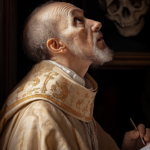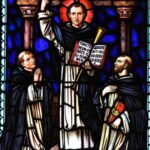St. Francis of Assisi
St. Francis of Assisi
When he lived: St. Francis of Assisi, also known as Francis Bernardone, was born in the year 1181 or 1182 (exact date uncertain) and died on October 3, 1226.
Where he lived: St. Francis was born in Assisi, a small town in Italy, and spent most of his life in and around this area.
Notable world events during the time of his life:
- The Third Crusade (1189-1192): This major conflict involved European powers attempting to retake Jerusalem and the Holy Land from the Muslim forces. Although this event had a strong religious component, it also had significant political and cultural impacts on the world.
- The Fourth Lateran Council (1215): A significant ecumenical council of the Catholic Church held in Rome, addressing various aspects of church doctrine, organization, and discipline.
- Magna Carta (1215): This historic document, often considered one of the foundational principles of constitutional law, was signed by King John of England, establishing certain rights and limitations on the monarchy.
- The rise of universities: The 13th century saw the rise of universities across Europe, such as the University of Paris. This period marked an important development in education and the pursuit of knowledge.
Patronage: St. Francis of Assisi is the patron saint of a wide range of causes, including animals, the environment, merchants, ecologists, and Italy. His love for animals and nature is particularly notable, as he is often depicted with animals and is the inspiration for many stories about his interactions with creatures.
Living the Dream—Really?
- His father, Pietro di Bernardone dei Moriconi, was a very wealthy
cloth merchant. Francesco’s mother, Giovanna, who was also known as Pica
Bourlemont, about whom little is known except that she is said to have
belonged to a noble family in Provence, France. So, in general,
Francesco belonged to the most well-off family in all of Assisi. Because
of their immense wealth and the privileges that his father had from the
authorities, Francesco obtained his education at the Catholic school of
San Giorgio. He spoke fluent Latin and Provençal and was considered by
his father, the natural successor of his family business.
From a Valiant Warrior to a Tame Sheep
But Francesco, with all the privileges and riches he enjoyed, dreamed of another thing. No, it is not about becoming holy! He wanted to become a knight. However, the best place to obtain the prestige and glory he longed for was through battle. Not long after, in 1202, he got his first opportunity when Assisi declared war on the nearby town of Perugia,their longtime enemy.
Most of Assisi’s soldiers were killed, while those who were wealthy were taken prisoners so that they would be ransomed. And yes, we are right that Francesco was one of those who were taken as prisoners. He was chained and thrown into a dark dungeon, and after a year, he was finally ransomed after his parents paid a substantial amount of money.
Francesco’s experience sparked a spiritual crisis. One day, while he was praying in the dilapidated church in San Damiano, Francesco heard Christ say three times from the crucifix: “Francesco, go repair my house,which, as you can see, is falling completely to ruin.” He understood that he was to repair the church he prayed in, though his followers later would realize that this was his call to reform the Church. So they went home and sold off their family goods to raise money for repairs. His father, Pietro, tried to bring him back to his senses, first with intimidation and threats, and then with corporal punishment. After a final interview in the presence of the bishop Guido II, Francis renounced his father and his wealth. He even laid aside the garments he had received from him. Seeing such a scene, the bishop clothed him with his mantle.
A Beggar Re-Building the House of God
Now stripped of wealth, Francesco lived as a beggar around Assisi. He embraced meditation, nursed lepers, and begged for the poor. Aside from the San Damiano Church, he restored several other ruined churches. Francesco’s way of life inspired other men, and so in 1209, he gathered a small group of 12 men who wished to share in his life and ministry. He wrote a Rule and set off for Rome to gain the pope’s approval for his work. This became the First Order of Franciscans, and Francesco was elected superior.
Francesco dedicated the rest of his life to helping the poor and preaching repentance. As he entered his mid-forties, illness afflicted his body, and he eventually became half blind. In his final years, Francesco composed his celebrated “Canticle of Brother Sun”, the poem that earned him his deserved reputation as one who marveled at God’s creation. He breathed his last on the evening of October 3, 1226, singing Psalm 141 while lying on the bare ground. His feast day is observed on October 4.
Five Interesting Facts About St. Francis of Assisi
- Two years before his death, St. Francis received the stigmata, the
real and painful wounds of Christ in his hands, feet, and side. - St. Francis attended the Fourth Lateran Council, where he met another
prominent religious figure, St. Dominic de Guzman. - There was a story about St. Francis and a wolf that had been eating
human beings. When the townspeople wanted to slay the wolf, St. Francis
intervened, and he talked the wolf into never killing again.
Miraculously, the wolf became a pet of the townspeople, who made sure
that he always had plenty to eat. - St. Francis’ holiness inspired many men and women; one of them was
St. Clare, who later founded the Order of Poor Ladies, now commonly
known as the Poor Clares. - St. Francis is the patron saint of ecology and animals.
Prayer to St. Francis of Assisi
Father, you helped Saint Francis reflect the image of Christ through a life of poverty and humility. May we follow Your Son by walking in the footsteps of Francis of Assisi and by imitating his joyful life. Grant this through Christ our Lord. Amen.



